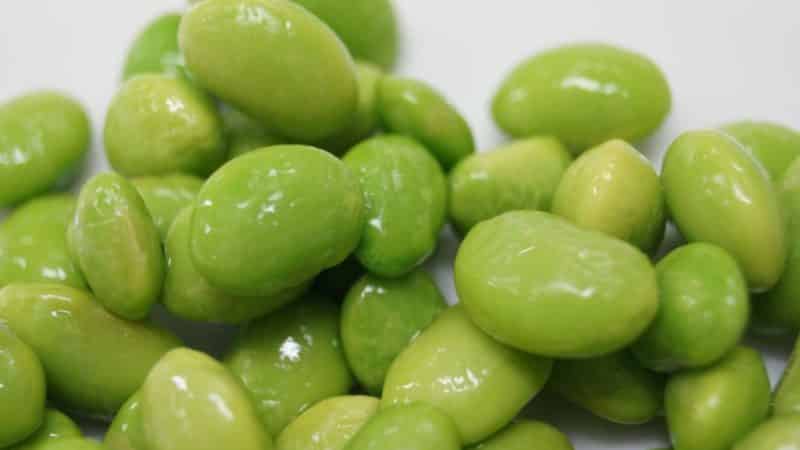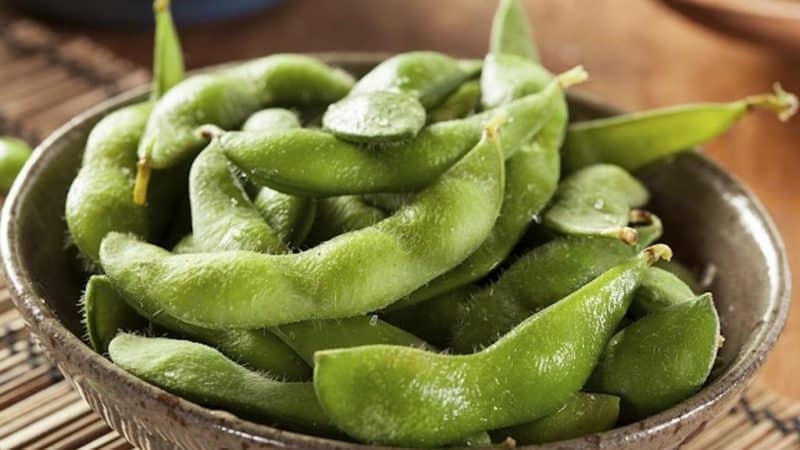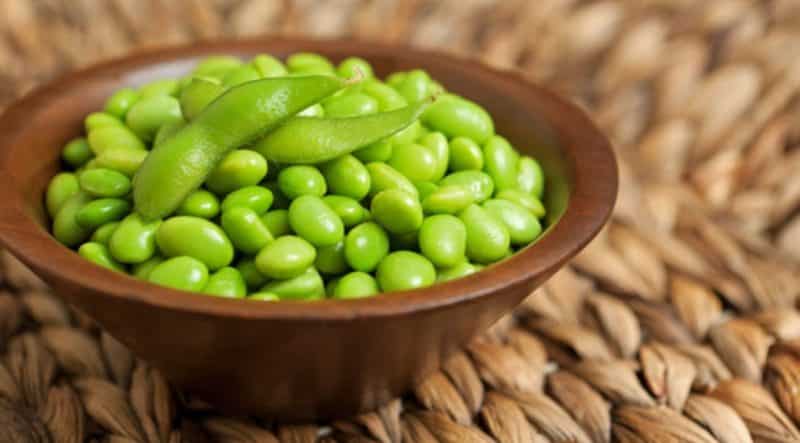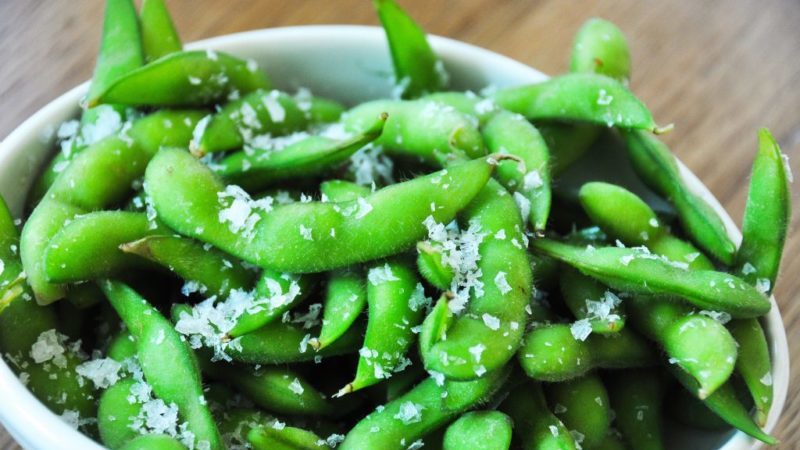Edamame beans - origin, benefits and features
In the wake of interest in new, unusual and healthy products, a variety of legumes are gaining popularity. These include edamame beans, which came to us from Japan and China. There is conflicting information about them: some call edamame a phase of soybean maturity, others claim that it is a special type of bean. To understand, we suggest studying the origin, features of growing and preparing the product.
What are edamame beans
Edamame is the name given to young, unripe, and therefore soybeans that have not yet hardened. Translated from Japanese, their name means “bean on a stalk.” The Chinese equivalent is called mao - “hairy bob”. Edamame is typically sold in pods and can be fresh or frozen.

Origin of Japanese edamame beans
The first written mention of edamame in Japan dates back to 1275 - this is a letter of gratitude from a certain monk Nichiren for donating beans to the temple. It is logical to assume that the product was known to Japanese chefs long before the appearance of this document.
The popularity of edamame is confirmed by the fact that they were glorified in haiku (17th century) and the creation of a specialized fair in one of the districts of Tokyo (18th century).
Unripe in China soybeans It was also used in folk medicine - advice on its use is found in the 15th century treatise “Medicines in Case of Trouble.”
Reference. In addition to Japan and China, edamame is used in cooking in India, Malaysia and Indonesia.
In Western culture, the spread of the product began in America in the mid-19th century. In Europe, edamame came into fashion only a few years ago. For example, the most authoritative Oxford Dictionary included the term in its composition only in 2003.
How to grow

Since edamame is not a special variety of soybean, but only a certain stage of ripeness of its fruit, the growing technology remains unchanged:
- Soybeans prefer fertile soils with a neutral or slightly acidic pH. The soil is harrowed before sowing to remove weeds and retain moisture.
- Sow in the second half of April - early May. Density – 35-40 beans per square meter. m.
- Provide good illumination of the planting area and regular watering during the flowering period. The temperature should not be lower than +14°C (optimally +21…+22°C).
- In the 5-6 leaf phase, they are fertilized with nitrophoska and then watered.
- Green pods are harvested 35-40 days after sowing. Harvesting is done by hand so as not to damage the beans.
Edamame pods should be bright green in color. Yellowed or darkened fruits indicate full ripening of soybeans.
Nutritional value and benefits of green soybeans
The main advantage of green soybeans is their low calorie content and high protein content - 121 kcal and 12 g, respectively.
The product is gluten and cholesterol free, but contains enough dietary fiber (5.2 g)
100 g of edamame contains:
- vitamins: A – 15 mcg, beta-carotene – 175 mcg, E – 0.7 mg, B1 – 0.2 mg, B2 – 0.2 mg, B3 – 0.2 mg, B4 – 56.3 mg, B5 – 0.4 mg, B6 – 0.1 mg, B9 – 311.0 mcg, K – 26.7 mcg, C – 6.1 mg;
- minerals: 436 mg potassium, 169 mg phosphorus, 64 mg magnesium, 63 mg calcium, 2.27 mg iron, 1.4 mg zinc, 0.8 mcg selenium;
- polyunsaturated fatty acids: 361 mg omega-3 and 1794 mg omega-6
Green soybeans contain more sucrose and abscisic acid (a plant hormone) than ripened ones.

Beneficial features product:
- used in the diet of patients with hypertension, diabetes mellitus, and progressive kidney disease;
- contains isoflavones that reduce the risk of cancer and osteoporosis;
- a rich source of folic acid, necessary for the formation of the nervous system in the embryo;
- phytoestrogens reduce cholesterol levels;
- relieves pain during migraines and premenstrual syndrome;
- calcium and phosphorus strengthen bone tissue;
- fiber improves intestinal function;
- antioxidants – isoflavones and saponins – protect against the harmful effects of free radicals;
- edamame helps fight depression, fatigue, and increases fertility in women;
- indispensable in vegetarian and weight-loss diets as a low-calorie source of complete plant protein.
Like any other product, edamame has contraindications and restrictions for use:
- disruptions of the endocrine system in children and adults;
- urolithiasis disease;
- colitis, ulcers and other disorders of the gastrointestinal tract;
- allergic reaction to soy;
- Use edamame with caution during pregnancy and lactation, as soy can disrupt the mother’s hormonal levels.
Edamame contains a large amount of phytoestrogens, which, when accumulated in the body, can lead to a decrease in potency in men.
This is interesting:
Varieties and varieties of beans: faba (garden), ornamental, large-fruited vegetable, fodder.
Cooking recipe

There are many ways to prepare edamame:
- frying;
- boiling in water or steaming;
- stewing;
- fermentation;
- pickling;
- fresh consumption.
However, traditionally in Japan, green soybeans are served boiled or steamed. The water is salted, and in some cases sugar is added. The beans are not husked, but left in the pods. In this form they can be a snack for beer and other drinks.
Beans extracted from the pod are added to soups, salads and sandwich fillings, and used as a side dish. Pounded edamame with sugar is a traditional glaze for Japanese rice dough balls (dango).
Interesting dishes include hummus, soy spread, dried snacks with various seasonings (sea salt or spicy wasabi).
Attention! An important rule is that cooked pods are eaten immediately or frozen for long-term storage.
Conclusion
Edamame is a non-trivial product that brings piquant variety to the usual diet. Young unripe soybeans have low calorie content, a rich vitamin and mineral composition and act as an alternative to meat for fasting and vegetarians. The beneficial properties of the product are varied, but there are also contraindications, the main of which are associated with an allergic reaction to soy and unstable hormonal levels.
One of the disadvantages of edamame is the relative rarity of such beans - they can only be purchased in large cities of Russia. The cost ranges from 200-300 rubles per 500 g of cooked-frozen product.